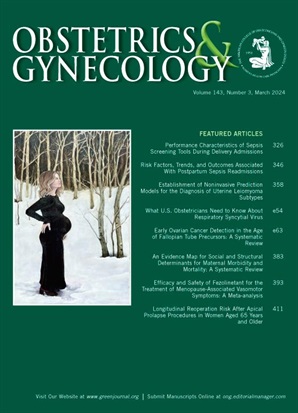Longitudinal Epigenetic Aging in Pregnancy and Associations With Adverse Outcomes.
IF 4.7
2区 医学
Q1 OBSTETRICS & GYNECOLOGY
引用次数: 0
Abstract
OBJECTIVE To understand the relationship between pregnancy and epigenetic aging estimated by DNA methylation "clocks," which offers a molecular measure of biologic aging. METHODS This was a prospective cohort study of nulliparous women (age 18-50 years) seeking obstetric (pregnant 10-14 weeks) or gynecologic (nonpregnant) care in 2020-2021. Blood was collected at enrollment (time 1) and postpartum day 1 (pregnant, time 2) or 7 months later (nonpregnant, time 2). Epigenetic age was measured with 11 established clocks from Illumina EPIC 2 arrays. Within-person changes in epigenetic age were compared with mixed-effects linear regression models adjusted for confounders and interval duration (days). Results were scaled per 200-day interval. P values were corrected for multiple testing. Multivariable logistic regression explored associations between first-trimester epigenetic age and a composite of potentially immune-mediated complications (hypertensive disorders, gestational diabetes mellitus, preterm birth before 37 weeks of gestation, and small-for-gestational-age birth weight) adjusted for age and body mass index (BMI) higher than 30 at time 1. RESULTS In total, 75 women enrolled; 45 (60.0%) were pregnant, and 61 (81.3%) completed the study. Pregnant women exhibited significant within-person epigenetic age acceleration compared with nonpregnant women in six clocks (Hannum, PhenoAge, GrimAge, GrimAge2, Stem Cell Division, DunedinPACE). Additional epigenetic age acceleration per 200 days in the pregnant cohort ranged from 1.58 years (Hannum, 95% CI, 0.45-2.72, P=.01) to 5.28 years (PhenoAge, 95% CI, 2.97-7.61, P<.01). Each additional year of first-trimester GrimAge2 increased odds of the composite of pregnancy complications by 36% (adjusted odds ratio [aOR] 1.36, 95% CI, 1.01-1.84), while chronologic age (in continuous years) showed no association (aOR 1.00, 95% CI, 0.83-1.21). CONCLUSION Pregnancy accelerated within-person epigenetic aging by up to 5.3 years. Older first-trimester GrimAge2, but not chronologic age, was associated with a composite of pregnancy complications. These findings suggest that gestation may influence biologic aging and support further investigation into epigenetic age as a potential marker of pregnancy health.妊娠期纵向表观遗传衰老及其与不良结局的关联。
目的了解通过DNA甲基化“时钟”估计的妊娠与表观遗传衰老之间的关系,这为生物衰老提供了分子测量。方法:这是一项前瞻性队列研究,研究对象是在2020-2021年期间寻求产科(怀孕10-14周)或妇科(未怀孕)护理的未生育妇女(18-50岁)。在入组时(时间1)和产后第1天(怀孕,时间2)或7个月后(未怀孕,时间2)采集血液。用Illumina EPIC 2阵列上的11个时钟测量表观遗传年龄。将人体内表观遗传年龄的变化与校正混杂因素和间隔时间(天)的混合效应线性回归模型进行比较。每隔200天计算一次结果。对多重检验的P值进行校正。多变量logistic回归探讨了妊娠早期表观遗传年龄与免疫介导的潜在并发症(高血压疾病、妊娠糖尿病、妊娠37周前早产和小于胎龄出生体重)的组合之间的关系,这些并发症经年龄和第1时间体重指数(BMI)高于30校正后。结果共纳入75名女性;45例(60.0%)怀孕,61例(81.3%)完成研究。与非孕妇相比,孕妇在6个时钟(Hannum, PhenoAge, GrimAge, GrimAge2, Stem Cell Division, DunedinPACE)中表现出显著的人内表观遗传年龄加速。在怀孕队列中,每200天额外的表观遗传年龄加速范围从1.58岁(Hannum, 95% CI, 0.45-2.72, P= 0.01)到5.28岁(PhenoAge, 95% CI, 2.97-7.61, P< 0.01)。妊娠早期每增加一年GrimAge2,妊娠并发症综合发生率增加36%(调整优势比[aOR] 1.36, 95% CI, 1.01-1.84),而实际年龄(连续年)无相关性(aOR 1.00, 95% CI, 0.83-1.21)。结论妊娠可使人体内表观遗传衰老加速达5.3年。孕早期年龄较大的GrimAge2与妊娠并发症相关,但与实际年龄无关。这些发现表明妊娠可能影响生物衰老,并支持进一步研究表观遗传年龄作为妊娠健康的潜在标志。
本文章由计算机程序翻译,如有差异,请以英文原文为准。
求助全文
约1分钟内获得全文
求助全文
来源期刊

Obstetrics and gynecology
医学-妇产科学
CiteScore
11.10
自引率
4.20%
发文量
867
审稿时长
1 months
期刊介绍:
"Obstetrics & Gynecology," affectionately known as "The Green Journal," is the official publication of the American College of Obstetricians and Gynecologists (ACOG). Since its inception in 1953, the journal has been dedicated to advancing the clinical practice of obstetrics and gynecology, as well as related fields. The journal's mission is to promote excellence in these areas by publishing a diverse range of articles that cover translational and clinical topics.
"Obstetrics & Gynecology" provides a platform for the dissemination of evidence-based research, clinical guidelines, and expert opinions that are essential for the continuous improvement of women's health care. The journal's content is designed to inform and educate obstetricians, gynecologists, and other healthcare professionals, ensuring that they stay abreast of the latest developments and best practices in their field.
 求助内容:
求助内容: 应助结果提醒方式:
应助结果提醒方式:


